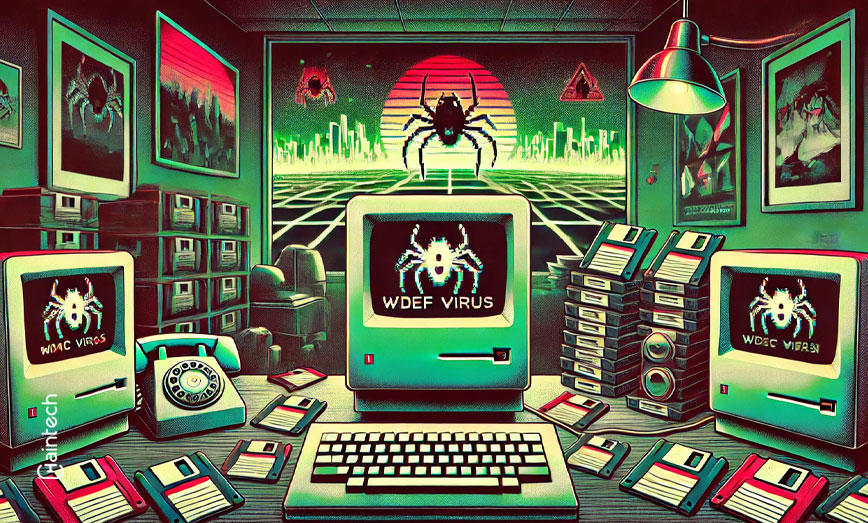MAC Virus 1989: WDEF and the Evolution of Mac Security

Have you ever wondered how a simple disk could turn your computer into a slow, crashing mess? Back in 1989, the WDEF Mac Virus did just that to countless Macintosh computers. It spread silently, without users even clicking anything. This was a time when viruses were mostly seen on PCs, so the Mac community was caught off guard.
What was WDEF? How did it spread so quickly? And most importantly, how did it change the future of computer security for Mac users? Keep reading to find out how the WDEF virus impacted the world and what lessons it left behind.
WDEF’s Silent Spread: The First Non-Executable Mac Virus
- WDEF was the first virus for Macs that didn’t need an executable file to spread, making it unique and more dangerous.
- Universities and software companies were heavily affected as the virus spread through floppy disks and removable media.
- WDEF taught the world an important lesson: Macs aren’t immune to viruses.
Now, let’s dig into the details and explore how the WDEF virus made its mark on history.
The Story Behind the WDEF Virus
In December 1989, the WDEF virus was discovered, shaking up the Mac community. What made it stand out was how it infected systems. Unlike other viruses, WDEF didn’t rely on executable files. Instead, it attached itself to Desktop files. That meant just inserting a disk was enough to get your system infected. No clicks, no downloads—just plug in the disk, and the damage was done.
The virus quickly spread through universities and companies. Schools like the University of Georgia and the University of Kentucky were among the first to report infections. The virus even made it as far as Belgium and was soon found in software products sold to the public.
For many, this virus was a rude awakening. Macs, which were considered safe from viruses, suddenly seemed vulnerable. People were forced to reconsider their idea of Mac security.
How Did WDEF Spread So Fast?
WDEF didn’t just infect a few systems—it spread like wildfire. Here’s how it worked:
- Automatic Infection: The virus would start infecting the system as soon as a disk was inserted. Users didn’t need to run any files or programs.
- Targeting Desktop Files: The virus attacked Desktop files, which were essential to the operating system. It didn’t just mess with one file—it affected every disk that was connected to the infected machine.
- Hidden Spread: Because the virus was so stealthy, it could spread without users even realizing it. Every time an infected disk was shared, the virus was passed on.
Did you know?
In 1990, the virus was found pre-installed on commercial software disks, spreading further without users having a clue.
Once the virus started spreading through shared media, it became nearly impossible to contain. Moreover, at universities, students and faculty would swap disks, unknowingly passing the virus along. Even worse, major companies like Microsoft distributed infected disks. As a result, it became clear that anyone using a Mac was at risk. Meanwhile, efforts to identify the source of the infection proved challenging.
Subsequently, antivirus programs were developed, but they arrived too late for many. Furthermore, the rapid spread highlighted vulnerabilities in digital ecosystems. Eventually, users became more cautious with shared media, but the damage had already been done. Consequently, this outbreak served as a wake-up call for better cybersecurity practices. In the end, the virus left a lasting impact on how people approached technology safety.
The Unexpected Reach of WDEF
WDEF didn’t stop at universities. It managed to infect software sold to the public. This added another layer of concern. If you bought a game or software, you could unknowingly be getting a virus too.
Here are a few examples of where WDEF was found:
| Software/Product | Date Found | Location |
| Grammatik | January 1990 | USA |
| Chessmate 2100 & Cribbing | April 1990 | USA |
| Institute for Scientific Info Diskette | April 1990 | USA |
| Diskworld Magazine Diskette | May 1990 | USA |
| Microsoft Excel | June 1990 | USA |
This wide-reaching impact showed just how dangerous WDEF was. It wasn’t just an isolated issue for universities; it had the potential to affect anyone who used a Macintosh.
How WDEF Hurts Macintosh Users
The effects of the WDEF virus were not just annoying—they were damaging. It caused system slowdowns, crashes, and even data loss. Let’s break down the major impacts:
Desktop File Corruption: WDEF corrupted desktop files, which are critical for the system. Icons disappeared, windows wouldn’t work correctly, and files would act strangely.
- System Failures: Macs would hang or crash, especially when trying to open or close windows. This problem was particularly bad on certain models like the Mac IIci.
- Data Loss: The virus caused serious issues with file systems, sometimes leading to the loss of important data.
- Security Breaches: Infected disks could easily spread the virus to other systems, making it a widespread issue in shared networks.
Expert Insights: What Made WDEF Different?
Ronald Greinke from the Virus Test Center at the University of Hamburg pointed out that WDEF was a game-changer. It was the first virus for Macintosh that didn’t use executable files. This new approach to infecting systems opened the door for more sophisticated viruses in the future.
WDEF’s ability to spread without user interaction was a wake-up call. It showed that Macintosh systems, once considered safe from such threats, were not immune to malware. This realization led to a shift in how people viewed computer security, especially for Macs.
WDEF’s Long-Lasting Impact
Even though WDEF was announced as a new discovery in 1989, the ‘damage’ lasted longer. It took a while for people to appreciate the magnitude of the devastation. When it was discovered, it was too late. The worm virus had, in fact, already spread across the globe, getting into countless machines.
Let’s take a look at the lasting impact the virus has left on the world:
- Mac Security Realization: WDEF showed the world that Macs were not invincible. It was a turning point for how people thought about security on Macintosh systems.
- Software Infections: The fact that WDEF was found on commercial software was shocking. It meant that even trusted software could be a carrier of viruses.
- Long-Term Spread: WDEF continued to appear in software and on disks well into the 1990s. Even years after its discovery, people were still finding it on old floppy disks and CDs.
Did you know?
As late as 1994, WDEF was still being found on CDs distributed by MacFormat, a UK-based magazine!
How Was WDEF Removed?
Removing WDEF wasn’t easy, especially with the technology available at the time. Here’s how it was managed:
- Bootable Virus Utilities: One common way to remove the MAC virus was using a bootable floppy disk loaded with a virus utility. You would physically access the infected system and run the utility to clean it. However, this method had limitations, especially for newer systems or ones without floppy drives.
- Updating MacOS: As MacOS evolved, it introduced built-in virus protection like XProtect Remediator. This tool could automatically scan and remove known malware like WDEF without needing to physically access the system.
These methods worked, but they required effort and often needed technical know-how. Over time, as the Mac operating system improved, dealing with viruses like WDEF became easier.
What WDEF Taught Us
The WDEF Mac Virus of 1989 left a lasting impression on the world of cybersecurity. It was more than just a virus—it was a lesson. WDEF demonstrated that people, even those who own Macs, can be affected by malware, thereby making it impossible for both the users and the developers of the Macs to change the way they think of security.
It was a lesson that viruses are able to propagate without any sound and reach such a variety of systems. Moreover, its infection attracted more sophisticated anti-virus programs. Consequently, developers introduced safer MacOS enhancements to address vulnerabilities. Furthermore, users began to recognize the importance of proactive measures. As a result, there was a significant shift toward greater awareness of the necessity to update one’s systems.
Meanwhile, the tech community worked tirelessly to develop stronger defenses. Subsequently, the focus shifted to educating users on cybersecurity best practices. In addition, companies began implementing stricter protocols to prevent similar outbreaks. Eventually, this incident became a turning point for modern cybersecurity strategies. Ultimately, it underscored the critical importance of staying ahead of potential threats.
For anyone curious about early Mac security threats, the WDEF virus is a critical piece of history that still resonates in today’s world of cybersecurity.
FAQs
1. How did the WDEF virus spread?
The WDEF virus spread through removable media like floppy disks. It infected desktop files automatically when a disk was inserted into an infected machine.
2. Why was WDEF so dangerous?
WDEF didn’t require users to execute any files. It spread silently and could infect multiple disks and systems quickly, making it hard to detect and remove.
3. How was WDEF removed from infected systems?
WDEF was typically removed using a virus utility on a bootable floppy disk or by updating MacOS to include built-in virus protection like XProtect Remediator.
4. Did WDEF only affect university computers?
No, WDEF spread far beyond universities. It was found on commercial software, games, and even CDs distributed by magazines.
5. What is the legacy of the WDEF virus?
WDEF was a major turning point for Mac security, showing that Macs were not immune to viruses. It led to the development of better antivirus tools and more secure operating systems for Macintosh users.









